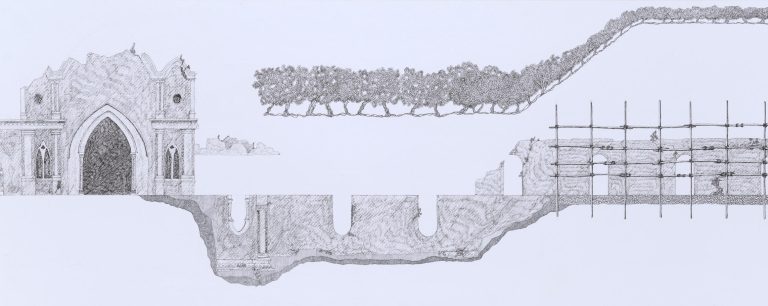We acknowledge the Traditional Owners of the land on which the Queensland Art Gallery | Gallery of Modern Art stands and recognise the creative contribution First Australians make to the art and culture of this country.

Jasmine Nilani Joseph / Sri Lanka b.1990 / The absence of the next door (detail) 2021 / Ink on paper / 15 sheets: 38 x 95cm (each) / Installed dimensions variable / Commissioned for APT10. Purchased 2021. QAGOMA Foundation / Collection: QAGOMA / © Jasmine Nilani Joseph
Jasmine Nilani JosephThe absence of the next door 2021
Not Currently on Display
The absence of the next door centres around events in Jasmine Nilani Joseph’s life, in particular the 2017 government release of land in Jaffna, including the site of her ancestors’ village, previously maintained as a high-security zone. At the beginning of 2018, the artist’s family was finally able to visit their old home and saw that a forest had grown around the abandoned houses. Nilani Joseph felt a longing to return and tend to the land and houses, but her parents compelled her to question the relationship between place and community, saying ‘there is no meaning to live in a place without our old neighbours. The empty land looks like another planet without our people’.1
Grappling with this tension inspired the artist to further delve into the motifs and objects that have signified neighbours and community throughout her life. Although devoid of figures, Nilani Joseph’s compositions suggest stories of everyday life and human habitation. Integrated into the architecture and landscape are cooking utensils, farming implements and crops — signifiers of shared activities. Abandoned and upturned buildings convey the displacement of resettlement, while spaces left around graves signify people lost.2
Within these landscapes carrying the memories of war and abandonment, Nilani Joseph creates an image of survival and adaptation. The artist draws attention to how — unlike borders and security fences — the walls between homes are the site of meetings and exchange, and that the importance of individual homes become evident through their relationship with surrounding buildings.
Endnotes:
1 Jasmine Nilani Joseph, email correspondence, 2021.
2 Jasmine Nilani Joseph, artist’s statement, 2021.
Jasmine Nilani Joseph’s distinctive drawings interrogate the ways land is demarcated, divided and inhabited. Through these renderings, the artist contemplates a sense of belonging and reflects on experiences of absence in her life and the community around her. In a seemingly endless arrangement of detailed ink-drawings, Nilani Joseph constructs snaking features of buildings, fences and structural and natural boundaries. These motifs act not only as symbols of division and displacement in the recent history of Sri Lanka but also as signifiers of new homes and new futures.
Nilani Joseph was born in the middle of the Sri Lankan Civil War (1983–2009), in the Northern city of Jaffna, at a time of renewed violence in the conflict. At the age of five, her family moved to a refugee camp in Vavuniya where her parents later settled and built a house. At this time, Nilani Joseph witnessed her family and their neighbours moving between their homelands and new territories, crossing borders of conflict and settling within new fence-lined zones. Gradually the artist observed her family become part of new communities, which continued to evolve and adapt throughout a long subsequent period of instability.